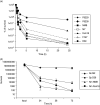Environmental survival of Neisseria meningitidis
- PMID: 23574798
- PMCID: PMC5340262
- DOI: 10.1017/S095026881300085X
Environmental survival of Neisseria meningitidis
Abstract
Neisseria meningitidis is transmitted through the inhalation of large human respiratory droplets, but the risk from contaminated environmental surfaces is controversial. Compared to Streptococcus pneumoniae and Acinetobacter baumanni, meningococcal viability after desiccation on plastic, glass or metal surfaces decreased rapidly, but viable meningococci were present for up to 72 h. Encapsulation did not provide an advantage for meningococcal environmental survival on environmental surfaces.
Figures

Similar articles
-
Survival of Neisseria meningitidis outside of the host: environmental effects and differences among strains.Epidemiol Infect. 2017 Dec;145(16):3525-3534. doi: 10.1017/S0950268817002473. Epub 2017 Nov 6. Epidemiol Infect. 2017. PMID: 29103405 Free PMC article.
-
Environmental desiccation stress induces viable but non culturable state in Neisseria meningitidis.Arch Microbiol. 2025 Jan 29;207(2):46. doi: 10.1007/s00203-025-04249-8. Arch Microbiol. 2025. PMID: 39878836
-
Infection with respiratory syncytial virus enhances expression of native receptors for non-pilate Neisseria meningitidis on HEp-2 cells.FEMS Immunol Med Microbiol. 1999 Feb;23(2):115-24. doi: 10.1111/j.1574-695X.1999.tb01230.x. FEMS Immunol Med Microbiol. 1999. PMID: 10076908
-
Cellular and molecular biology of Neisseria meningitidis colonization and invasive disease.Clin Sci (Lond). 2010 Feb 9;118(9):547-64. doi: 10.1042/CS20090513. Clin Sci (Lond). 2010. PMID: 20132098 Free PMC article. Review.
-
Antimicrobial peptide resistance in Neisseria meningitidis.Biochim Biophys Acta. 2015 Nov;1848(11 Pt B):3026-31. doi: 10.1016/j.bbamem.2015.05.006. Epub 2015 May 19. Biochim Biophys Acta. 2015. PMID: 26002321 Free PMC article. Review.
Cited by
-
Regulation of capsule in Neisseria meningitidis.Crit Rev Microbiol. 2016 Sep;42(5):759-72. doi: 10.3109/1040841X.2015.1022507. Epub 2015 Jun 19. Crit Rev Microbiol. 2016. PMID: 26089023 Free PMC article. Review.
-
Effect of speech volume on respiratory emission of oral bacteria as a potential indicator of pathogen transmissibility risk.J Acoust Soc Am. 2020 Oct;148(4):2322. doi: 10.1121/10.0002278. J Acoust Soc Am. 2020. PMID: 33138475 Free PMC article.
-
Detection of Streptococcus pneumoniae, Neisseria meningitidis and Haemophilus influenzae in Culture Negative Cerebrospinal Fluid Samples from Meningitis Patients Using a Multiplex Polymerase Chain Reaction in Nepal.Infect Dis Rep. 2021 Mar 1;13(1):173-180. doi: 10.3390/idr13010019. Infect Dis Rep. 2021. PMID: 33804301 Free PMC article.
-
Direct whole-genome sequencing enables strain typing of unculturable Neisseria meningitidis from oropharyngeal carriage specimens.Microb Genom. 2025 Aug;11(8):001464. doi: 10.1099/mgen.0.001464. Microb Genom. 2025. PMID: 40758406 Free PMC article.
-
Neisseria meningitides Can Survive in Corpses for At Least Eleven Days.Front Cell Infect Microbiol. 2016 Jul 13;6:74. doi: 10.3389/fcimb.2016.00074. eCollection 2016. Front Cell Infect Microbiol. 2016. PMID: 27468408 Free PMC article. No abstract available.
References
Publication types
MeSH terms
Grants and funding
LinkOut - more resources
Full Text Sources
Other Literature Sources

